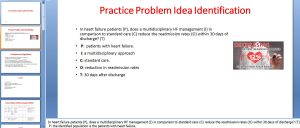Instructions
This assignment has four components:
1. Identified practice problem idea in PICOT format
2. Failure Mode and Effects Analysis
3. Ishikawa (Fishbone) cause and effect diagram
4. Professional PowerPoint with speaker notes at the bottom of each slide to disseminate information
Follow these guidelines when completing each component of the assignment. Contact your course faculty if you have questions.
1. Consider the identified practice problem idea used in the Week 4 translation science project including PICOT, background, and significance. Incorporate course faculty feedback from the Week 4 assignment.
2. Review the examples of the failure mode and effects analysis and fishbone diagram in the Week 4 Explore section of the course called Evidence-Based Practice: Improving Outcomes.
3. Download the required documents inserted in the guidelines:
a. Link (PPT): PowerPoint Template (Links to an external site.)
b. Link (Word doc): Failure Mode and Effects Analysis Template (Links to an external site.)
c. Link (Word doc): Ishikawa Fishbone Template A (Links to an external site.) (Word 2016 or higher)
d. Link (Word doc): Ishikawa Fishbone Template B (Links to an external site.) (older version of Word)
4. Complete the failure mode and effects analysis and then the Ishikawa fishbone diagram. The Ishikawa fishbone diagram requires Word 2016 to download. If you do not have the Word 2016 version, you may update your current version of Word (click on the following link for instructions: Office 365 (Links to an external site.)) or use the alternative version provided or create your own fishbone diagram as long as you are addressing the five areas:
a. People
b. Environment
c. Materials
d. Methods
e. Equipment
5. Create the PowerPoint Presentation.
The assignment should include the following components. Use the templates provided for the assignment.
1. Introduction (1 slide)
a. Title of Practice Problem Analysis Presentation
b. Student Name
c. Assignment Title
d. Course Faculty Name
2. Practice Problem Identification (1-3 slides)
a. State identified practice problem as a PICOT question in question format.
b. Identify all PICOT components.
c. Describe the background and significance of the identified practice problem idea (cited).
d. Develop inclusion criteria for the population of interest.
e. Develop exclusion criteria for the population of interest.
3. Failure Mode and Effects Analysis (1-2 slides)
a. Identify three steps in the identified practice problem idea process with potential breakdown or process gaps.
b. Identify at least one potential error (failure mode) for each of the three process steps.
c. Identify at least one possible cause of failure (failure cause) for each of the three process steps.
d. Identify at least one adverse consequence (failure effect) for each of the three process steps.
e. Using a scale 1-10, rate likelihood of occurrence of failure for each process step.
f. Using a scale 1-10, rate likelihood of detection of failure for each process step.
g. Using a scale 1-10, rate likelihood of severity of harm if failure occurs for each process step.
h. Calculate the Risk Profile Number (Multiply likelihood of occurrence X likelihood of detection X likelihood of severity or harm).
i.Summarize FMEA analysis.
Note: The following article has scoring guidelines for FMEA ratings which may be helpful.
Warnick, R. E., Lusk, A. R., Thaman, J. J., Levick, E. H., & Seitz, A. D. (2020). Failure mode and effects analysis (FMEA) to enhance safety and efficiency of Gamma Knife Radiosurgery. (Links to an external site.) Journal of Radiosurgery and SBRT, 7, 115-125.
4. Ishikawa (Fishbone) Cause and Effect Diagram (1-2 slides)
a. Identify people involved in the identified practice problem idea.
b. Identify the environment in which the identified practice problem idea occurs.
c. Identify the materials used.
d. Identify the methods used.
e. Identify the equipment used.
f. Summarize cause and effect analysis.
5. Evidence-Based Intervention (1 -2 slides)
a. Identify the evidence-based intervention for your identified practice problem idea (listed in PICOT).
b. Identify barriers to overcome based upon what you learned from the FMEA and Fishbone Analyses.
c. Discuss feasibility of the evidence-based intervention.
6. Conclusion (1 slide)
a. Summarize the purpose and findings of the analysis.
b. Provide and justify the main conclusions.
c. Draw inferences from the quality improvement analysis.
7. References (1 slide)
a. Include in-text citations used in the presentation.
b. Provide complete matching references in correct APA format.
c. Include minimum of four scholarly sources.
Writing Requirements
· Length: Maximum of 14 slides
· Standard English usage and mechanics
· APA format guidelines for in-text citation and references
· Clear, succinct, and readable slides
· Elaboration on the slide questions
· Speaker notes section with legible comprehensive notes for each slide
Solution:
